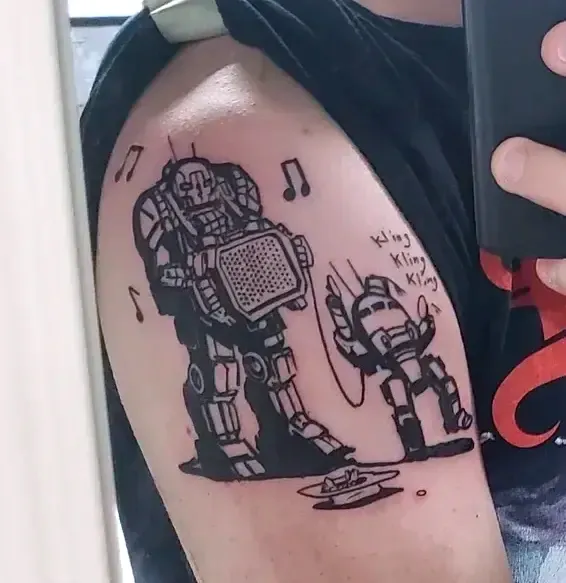Unnecessary Nerd Math - Calculating the Expected Heat of a Battletech Plasma Rifle
I might be a bit of a Battletech fan.

Battletech is a game about making giant robots shoot and beat each other to hell. As a wargame, it can get a little complicated. A big part of playing involves not over-exerting machines, as they will get too hot and start to malfunction. I was playing with my brother last week, who built a force around trying to get my mechs to overheat with two weapons: flamers and plasma rifles. I took interest in the plasma rifles, which instead of doing constant heat to a target, do a random 1d6 heat.
This made me wonder how much heat to expect from each plasma rifle fired at me.
In order for a plasma rifle to generate heat, the attacker must successfully hit the target with the weapon. In Battletech, attack hits are determined by rolling two dice. To land a hit, the sum of the dice must be equal to or higher than some determined to-hit number. The number is determined by where players place units, intervening terrain, and other factors. But most importantly, a modifier can be anywhere from 2-12[1]. On a successful hit with a plasma rifle, the attacker does damage and the aforementioned 1d6 heat.
Since the player has control over the to-hit modifier for the first roll, but no control over the second 1d6 roll, I decided to calculate expected heat as a function of the to-hit modifier $t$.
Let $1d6$ be the random variable for rolling a single die[2] and $2d6 \equiv 1d6+1d6$ be the random variable for rolling two dice. We have two events we are interested in. One is the event where the player hits by rolling over some to-hit modifier $t$:
$$
2d6 \ge t
$$
The second event is the amount of heat $h$:
$$
1d6 = h
$$
To find an expectation, we want to calculate the probability density function of hitting the target and doing some random heat value:
$$
RifleHitAndHeat(t,h) \equiv \mathbb{P}(2d6\ge t \cap 1d6=h)
$$
Of important note is that we have two different dice rolls here, and the value of the to-hit roll has no effect on the value of the heat roll, so both of these rolls are independent events. That means if we can find the probabilities of each event separately we can multiply them together to find their joint probability.
With this in mind, let's find $\mathbb{P}(2d6 \ge t)$. To do this we can calculate the number of ways we can roll each $2d6 \ge t$ event and divide it by the total number of unique dice rolls ($6\times6=36$).
Now we need to count how many ways we can roll $2d6 \ge t$. Let's call this count $b(t)$. To start, we note there is only one way to roll $t=2$, and there are no rolls less than 2, so there are 36 ways to beat $t=2$. We can then count by hand how many ways there are to roll $t=3$, $t=4$, and so forth, subtracting $t$ rolls from the number of ways we can beat $t-1$ rolls. These counts and their associated probabilities are spelled out in the table below:
| $t$ | 2 | 3 | 4 | 5 | 6 | 7 | 8 | 9 | 10 | 11 | 12 |
|---|---|---|---|---|---|---|---|---|---|---|---|
| number of ways to roll $t$ | 1 | 2 | 3 | 4 | 5 | 6 | 5 | 4 | 3 | 2 | 1 |
| number of ways to beat $t$, $b(t)$ | 36 | 35 | 33 | 30 | 26 | 21 | 15 | 10 | 6 | 3 | 1 |
| Chance of hitting $\mathbb{P}(2d6 \ge t)=\frac{b(t)}{36}$ | 36/36 | 35/36 | 33/36 | 30/36 | 26/36 | 21/36 | 15/36 | 10/36 | 6/36 | 3/36 | 1/36 |
| $P(2d6 \ge t)$ as a decimal | 1.000 | 0.972 | 0.917 | 0.833 | 0.722 | 0.583 | 0.417 | 0.278 | 0.167 | 0.083 | 0.028 |
Now we calculate $\mathbb{P}(1d6=h)$. Since each of the six faces of a single die has an equal chance of occurring, we know $P(1d6=h)=\frac{1}{6}$ for all possible $h$ ($1$ through $6$).
We can now calculate the probability $RifleHitAndHeat(t,h)=\mathbb{P}(2d6\ge t \cap 1d6=h)$ as such:
$$
\begin{aligned}
\mathbb{P}(2d6 \ge t \cap 1d6=h) & = \mathbb{P}(2d6 \ge t)\times \mathbb{P}(1d6=h) \\
& = \frac{b(t)}{36}\times \frac{1}{6} \\
& = \frac{b(t)}{216}
\end{aligned}
$$
Note that since $\mathbb{P}(1d6=h)$ is constant, $RifleHitAndHeat(t,h)$ can be expressed as just a function of $t$, or in other words, $RifleHitAndHeat(t,h)=RifleHitAndHeat(t)$. Now we can take the expectation of a random variable representing a plasma rifle being fired, $H_{Rifle} \sim RifleHitAndHeat(t)$.
$$
\begin{aligned}
\mathbb{E}(H_{Rifle}) & = 1\times \frac{b(t)}{216}+2\times \frac{b(t)}{216}+3\times \frac{b(t)}{216}+4\times \frac{b(t)}{216}+5\times \frac{b(t)}{216}+6\times\frac{b(t)}{216} \\
& = (1+2+3+4+5+6)\times \frac{b(t)}{216} \\
& = \frac{7}{72}\times b(t)
\end{aligned}
$$
We can use this function to fill in the table below, giving us the expected heat for each possible to-hit modifier.
| $t$ | 2 | 3 | 4 | 5 | 6 | 7 | 8 | 9 | 10 | 11 | 12 |
|---|---|---|---|---|---|---|---|---|---|---|---|
| Expectation: $\mathbb{E}(H_{Rifle})$ | 3.500 | 3.403 | 3.208 | 2.917 | 2.528 | 2.042 | 1.458 | 0.972 | 0.583 | 0.292 | 0.097 |
As an initial sanity check we can note that the expectation at $t=2$ is 3.5, the exact expectation of only having to roll 1d6. This makes sense because a to-hit of 2 is an automatic hit. Further, the following python script builds a markdown table confirming these results.
import random
TRIALS = 10**5
header_string = "|t|"+"|".join(str(i) for i in range(2,13))+"|"
print(header_string)
print("|"+"---|"*12)
print("|Expectation: $\mathbb{E}(H)$|", end='')
for to_hit in range(2,13):
total_heat = 0
for _ in range(TRIALS):
# roll two dice
first_die = random.randint(1,6)
second_die = random.randint(1,6)
dice_roll = first_die + second_die
if dice_roll >= to_hit:
heat_die = random.randint(1,6)
# roll heat, mark success if heat is 3
total_heat += heat_die
print(f"{total_heat/TRIALS:3.3f}|", end='')
print()
| $t$ | 2 | 3 | 4 | 5 | 6 | 7 | 8 | 9 | 10 | 11 | 12 |
|---|---|---|---|---|---|---|---|---|---|---|---|
| Expectation: $\mathbb{E}(H_{Rifle})$ | 3.498 | 3.404 | 3.200 | 2.915 | 2.538 | 2.039 | 1.453 | 0.971 | 0.587 | 0.292 | 0.097 |
Now, fans of Battletech know there are not only plasma rifles, but also plasma cannons. As opposed to 1d6 heat, plasma rifles do 2d6 heat. So to calculate their expected heat, we need to calculate a slightly different probability distribution function.
$$
H_{Cannon} \sim CannonHitAndHeat(t,h) = \mathbb{P}(2d6\ge t \cap 2d6=h)
$$
This is slightly more complicated as there can be multiple ways to roll $2d6=h$ so $\mathbb{P}(2d6=h)$ is no longer constant. In my next Battletech post I will work out computing this new expectation!
There are technically ways to get your to-hit modifier below 2 or above 12. In the former case the attacker always hits (you cannot roll two dice lower than 2) making the expected heat 3.5. In the latter (you cannot roll two dice greater than 12) the attacker always misses, making it 0. ↩︎
Since each face on the die appears equally likely this roll is usually referred to as $U\{1,6\}$, or the discrete uniform distribution over the support
$\{1,2,3,4,5,6\}$. ↩︎
